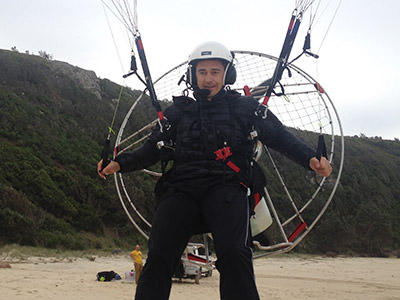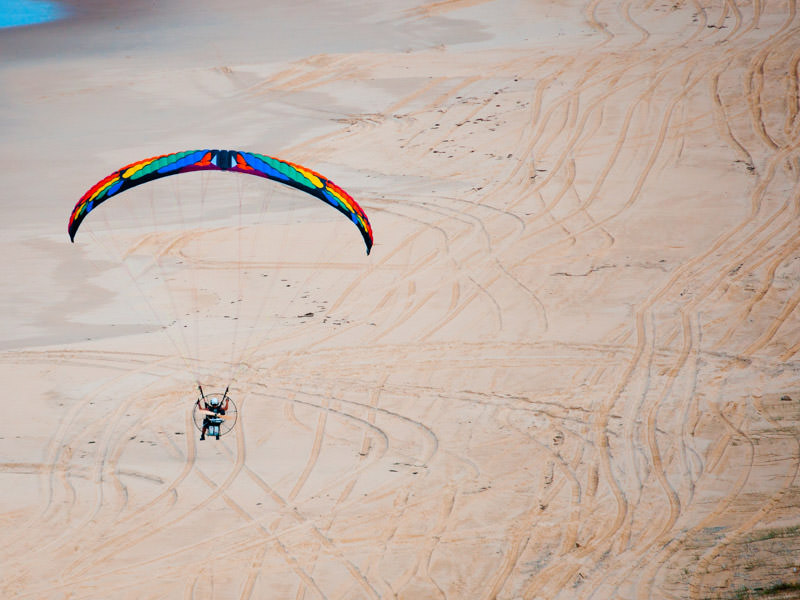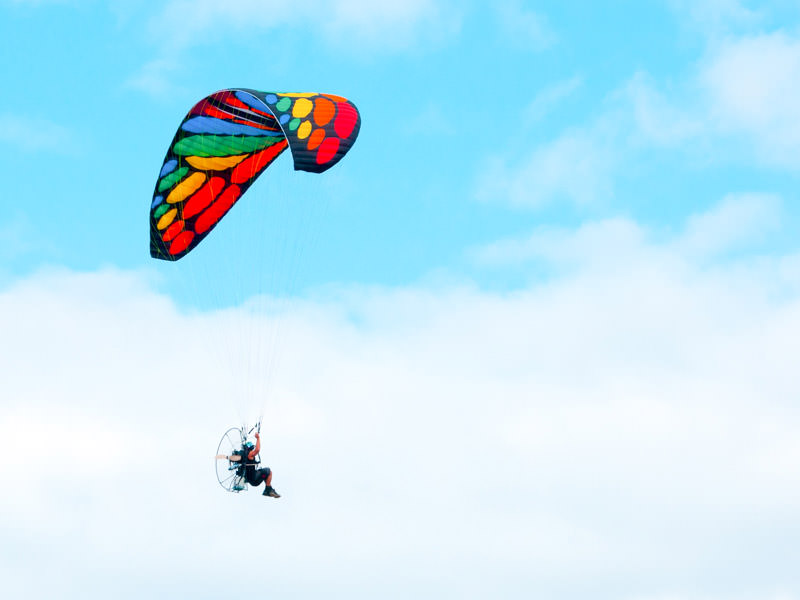3 DAY PARAMOTOR ENDORSEMENT COURSE
Are you ready for wind in your hair?14 DAY STRAIGHT-THROUGH PARAMOTOR TRAINING COURSE
Nothing like the smell of 2-stroke! Course options starting from
2024 COURSE DATES
March
Sunday 10th March to Sunday 17th March 2024: 8-Day Learn To Paraglide Novice Course - Enquire Now
Sunday 10 March to Saturday 23rd March 2024: 14-Day Straight-Through Learn to Paramotor Course - Full - See Apr & March dates
April
Sunday 14th April to Sunday 21st April 2024: 8-Day Learn To Paraglide Novice Course - Enquire Now
Sunday 14th April to Saturday 27th April 2024: 14-Day Straight-Through Learn to Paramotor Course - Enquire Now
2024 Paragliding and PPG Course Date Overview
November
Sunday 19th November to Sunday 26th November 2023: 8-Day Learn To Paraglide Novice Course - Enquire Now
Sunday 19th to Saturday 2nd December 2023: 14-Day Straight-Through Learn to Paramotor Course - Enquire Now
December
Sunday 10th December to Sunday 17th December 2023: 8-Day Learn To Paraglide Novice Course - 2 Places Remaining Enquire Now
January
Sunday 21st January to Sunday 28th January 2024: 8-Day Learn To Paraglide Novice Course - Full - See Feb & March dates
Sunday 21st January to Saturday 3rd February 2024: 14-Day Straight-Through Learn to Paramotor Course Full - See Feb & March dates
February
Sunday 11th February to Sunday 18th February 2024: 8-Day Learn To Paraglide Novice Course - Enquire Now
Sunday 11th February to Saturday 24th February 2024: 14-Day Straight-Through Learn to Paramotor Course 1 Place Remaining- Enquire Now
March
Sunday 10th March to Sunday 17th March 2024: 8-Day Learn To Paraglide Novice Course - Enquire Now
Sunday 10 March to Saturday 23rd March 2024: 14-Day Straight-Through Learn to Paramotor Course - Full - See Apr & March dates
April
Sunday 14th April to Sunday 21st April 2024: 8-Day Learn To Paraglide Novice Course - Enquire Now
Sunday 14th April to Saturday 27th April 2024: 14-Day Straight-Through Learn to Paramotor Course - Enquire Now

.. After completing my PPG Endorsement at Cloudbase, I can highly recommend the Cloudbase team! Chris and Mark have created a fun and relaxed environment to live and learn, their teaching skills (and patients) are second to none and their equipment is amazing to fly. Thanks guys
3 DAY PARAMOTOR ENDORSEMENT COURSE
Got two stroke in your blood? Let’s do it!!
More about this course
RUN ALL YEAR ROUND. COURSE DATES ARE HERE
Course cost is $1090.00 using your equipment and $1490.00 using our range of new-technology, lightweight equipment.
Our Paramotor endorsement program is a 2-3 day program until you complete the necessary requirements. We want you to leave our school well skilled in light and moderate wind conditions, where you can control and competently fly a Paramotor.
We do not rush you through the course.
We take great care in ensuring you are well trained, as inevitably being half taught you will break your equipment and possibly yourself. It normally takes 2 full days of training to complete the endorsement course if your ground skills are up to speed.
Endorsement courses are held at our locations at Gloucester, Laurieton and Port Macquarie NSW, with our long-established CFI Instructors to assist you in your dream of Paramotoring. Our Paramotor endorsement course will cover light to moderate to wind launching and landing followed by safety procedures and checks that will keep your gear in the air and not on the ground in pieces. You are also required to do one XC flight by the completion of the course.
In most cases, your instructor or another pilot will take this flight with you. Early mornings and late afternoons are best for learning Paramotoring inland but if we are teaching on the coast, we can teach all day if we have a light sea breeze, so location and weather will decide flight location.
We use the latest Paramotoring equipment that is light and powerful that starts with ease and doesn’t feel like a ship’s anchor on your back!! We use both electric start and manual start Paramotors and sometimes combine towing with our training. Being trained on the right gear that is suited to your skill level and weight is so important.
Choose wisely where you learn and what equipment you are taught on. Our heaviest Paramotor weighs 24kg that can lift a 120kg pilot.
We hear that some pilots are being trained on units 30kg – 40kg, just think what it would be like landing awkwardly with that weight on your back?
Important Prerequisite Information: You must hold an Intermediate Pilot Certificate before undertaking any paramotor training. Additional to completion of this course, you will be required to have a VHF Radio Operators Rating to be fully endorsed to fly a Paramotor unsupervised.
Cloudbase Paragliding Australia is one of only 3 schools in the country that offer training prior to you reaching that criteria, and all hours trained on Paramotor are included.
What to expect with Cloudbase Paragliding
PRACTICAL PRE FLIGHT Canopy ground handling Pre take off paramotor control Post landing control of paramotor Parking the paramotor Unpowered slope/winch take offs
FLIGHT TASKS 3 powered flights over 100 AGL 90 turns 3 Target landings Minimum 10 logged paramotor flights Demonstrate 360 turns Demonstrate power off landings Demonstrate forward & reverse launches Complete a flight of a least 20km to goal EXAMINATION
THEORY THE POWER UNIT Have read and understand Owners Manuals Configuration including two stroke operation Mixing fuel Safety Operator and Flight Manual Starting procedures Power generated Torque Effects, Gyroscopic Precession & Asymmetric blade thrust Hang points and effect of altering Weight checks
POWER CHECKS Clearing the fuel supply of bubbles Clear prop Cut off switch Power on
THEORY & FLIGHT Thrust & Drag Forces in turns Climbing and diving in turns Propeller Theory
TAKING OFF Choice of safe field including climb out clearance, ground conditions, turbulence generators & power fail contingency plan Assessment of conditions Safe areas for onlookers Noise nuisance Methods of inflation The run use of brakes Emergency stopping (launch abort)
FLIGHT THEORY Micrometeorology found in XC conditions Speed systems and trimmers effects with power on and off Navigation Exercise. The student will plan a 30km flight to a declared goal.
FLYING RULES Congested areas Flying over water
AIR LAW Aeronautical Charts Restricted & prohibited Airspace Line features Quadrantal rule VMC minima
LANDING Power on/off Kill switch management Light/ high wind
..I came from Western Australia to do my Paramotor course with Chris and Mark because they came so highly regarded. The best thing about the course, other than having a great time with the lads was returning home extremely confident and skilled to fly my paramotor. Thanks fellas!
14 DAY STRAIGHT-THROUGH PARAMOTOR TRAINING COURSE
The complete go-to-whoa straight through package!
More about this course
RUN ALL YEAR ROUND. COURSE DATES ARE HERE
We are one of three schools in the country that can offer this straight-through training package.
Course cost is $4300.00 using your equipment and $4800.00 using our range of new-technology, lightweight equipment.
The basic Paragliding course normally takes around 7-8 days to complete and then you spend the remaining days undertaking Paramotoring training. It is important to understand, however, that you must accumulate 20 hours of supervised flying time with a minimum of 30 flights (including at minimum a guided 10km XC flight), over 12 days of training. This course will also encapsulate your VHF Radio Operators accreditation. Additionally, you will receive your Paragliding Free Flight Endorsement with us at no extra cost. Please allocate a minimum of 14 days duration to ensure sufficient poor weather days.
Our instructors have DECADES of experience (one of them even co-authored the current syllabus). We have contacts with Senior Safety Officers and Paragliding and Paramotoring Clubs Australia-wide to assist you in this very important matter that other operators are failing to inform their clients.
With our team, we don’t rush you through the course. We don’t wear you into the ground. We take our time with you and make sure you are learning on the best gear that is light, modern and powerful and that you are 100% comfortable with being taught at your pace.
Don’t end up like others that get rushed through a course and get home and feel that you’re not 100% competent. It’s a bad situation to be in after spending $1000’s of dollars. Don’t learn with gear that’s like a ship’s anchor on your back!
What to expect with Cloudbase Paragliding
Introduction to the sport and flight operations.
Basic Aerodynamics
Canopy and equipment introduction and appreciation
Introducing you the components, assembly and pre-flight inspection checking procedures.
Ground Handling (canopy control)
Understanding and managing the glider pitch and roll control in a variety of conditions.
Motor Equipment Familiarisation
Introducing you to and familiarising you with the motorised equipment assembly, set-up, and associated run-up and pre-flight checks.
First Glides
One you have the basics down, we introduce you to paragliding free flight. Here you will undertake your first short solo glides under fully-led radio instruction.
Full Paragliding Training
Whilst the straight-though paramotor syllabus lends itself to train with a minimum of paragliding training, we are of the firm opinion that the better the paraglider pilot you are, the better and more proficient paramotoring pilot you will become. As a result, you’ll have the added benefit of leaving our school with the free-flying endorsement.
Unpowered and powered Glides
Here you will achieve the take-off and landing techniques that will familiarise yourself with having the motorised power unit on your back.
Core Competencies and Activities – Powered Flight
Once you have mastered unpowered flight, you are now ready to experience powered flight. All of your hard work has been leading up to this point. Here you will learn additional radio protocols, fuel mixing, engine maintenance, start and kill processes and sequences, propeller awareness and associated safety protocols, ground handling with power, inflation/deflation techniques, take-off refinement techniques, throttle and altitude management, pitch, roll control and thrust force management techniques, flat turning, shallow banked turns, 180 and 360 degree turns, big-ear techniques, trim tab management, air-speed control, landing in a variety of conditions, landing accuracy, flare development, circuit, route and course planning, fuel management, engine-out management, managing emergencies in flight, and general active piloting skills.
Meteorological Theory
Here you will obtain an opportunity to be familiar with the basics of aviation meteorology and understand the concept of micrometeorology and be able to explain the relationship between air movement and glider/wing behaviour and performance. Here we will also provide familiarity for how to obtain meteorology observations, and understand weather charts.
Human Factors
VHF Radio Operators Endorsement
In this training phase, you will understand and learn about the use of VHF Radio and CASA requirements governing radio procedures and be able to explain the rules associated with radio operations.
Navigation
Understand navigating your aircraft under visual meteorological conditions using pilot navigation methods and understanding how to read a VTC and interpret Airspace restrictions.
Maintenance
Understanding how to maintain your aircraft and engine to manufacturer’s specifications.
Booking your course position is easy, simply check the course dates here







